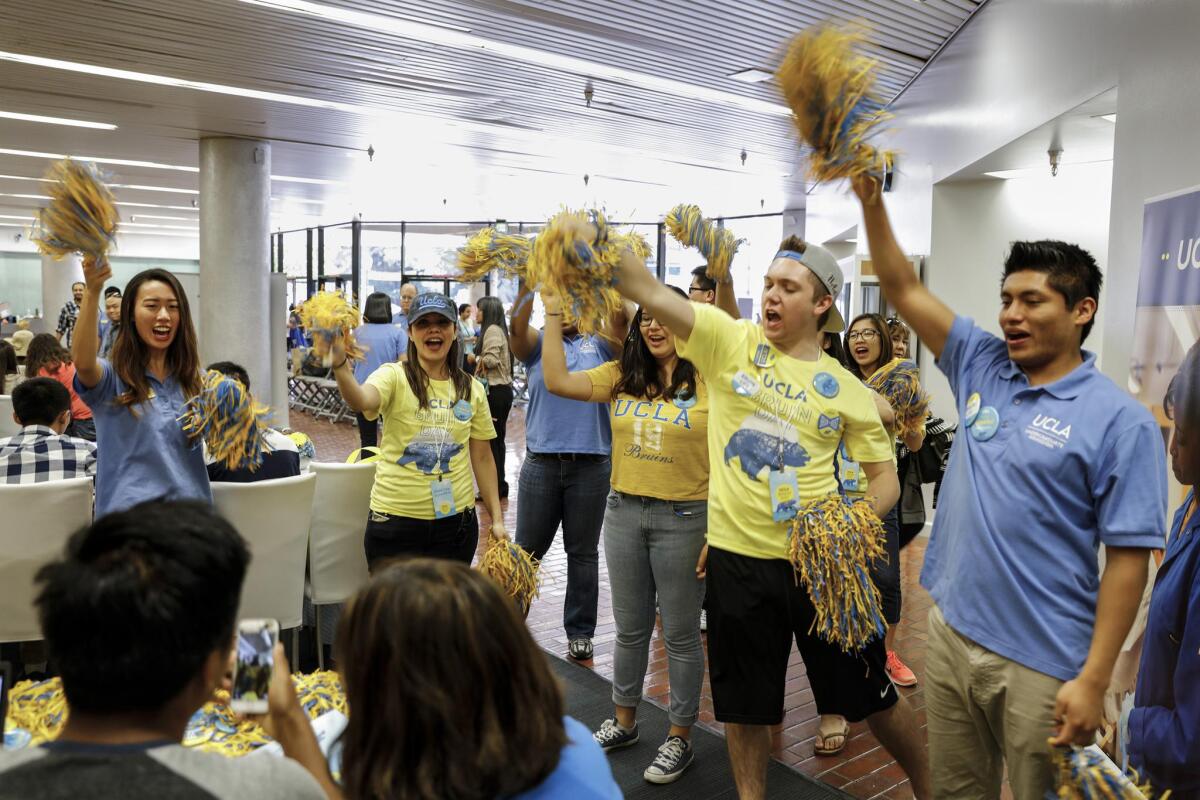UC enrolls record number of California students in the fall

- Share via
The University of California enrolled a record number of in-state undergraduates in the fall, marking the fourth consecutive annual increase, according to data released Tuesday.
UC’s nine undergraduate campuses enrolled a total 185,559 California residents during the current academic year — a 10.3% increase of 17,369 since 2015. All campuses but Santa Barbara and Santa Cruz increased their in-state students.
Although total California undergraduate enrollment increased in fall 2019, new freshmen and transfer students declined slightly by 1%. During this period UC experienced the first dip in freshman applications in 15 years.
Experts were unsure whether that was a temporary blip triggered by wildfires and other natural disasters that made it harder for students to apply, or the start of a gradual decline as the number of high school graduates decreases, immigration policies tighten up and more students start at community college under a new state tuition waiver.
UC did admit a record number of California students for fall 2019, but it appears that fewer accepted the admission offers and enrolled.
UC President Janet Napolitano said the overall enrollment growth “means expanded opportunities for a new generation of young people. The University of California is looking forward to providing these talented, hardworking students a world-class education, while expanding access for future Californians.”
Systemwide, 40% of those enrolled this academic year are the first in their families to attend college, while 36% qualified for Pell Grants — federal financial aid most often awarded to students whose annual family incomes are less than $30,000.
Asian Americans remained the largest group at 33.5%, followed by Latinos at 24.8%, whites at 21.4% and blacks at 4.1%. And more female undergraduates enrolled than men, 54% to 45%, the continuation of a longtime trend. The most popular majors among women were social sciences and life sciences, compared to engineering and computer science for men.
The UC system has been under pressure from state officials to enroll more Californians after that group’s freshman admission rates fell from 85% in 2009 to 59% in 2018.
Campuses rapidly increased nonresident students in the years following the 2008 recession because they pay supplemental tuition of nearly $30,000 in addition to the base amount charged to all students. But controversy over their rising numbers prompted the UC regents to cap their enrollment in 2017.
Not all student groups increased enrollment. Freshmen from foreign countries declined for the first time in more than a decade — dropping 4.77% in fall 2019 over the previous year.
Many undergraduates say they chose a UC school because of the system’s reputation as the nation’s top public research university, relatively low cost and generous institutional and state financial aid
One newly enrolled UC student is Yi Fang, who emigrated from China at age 9, learned English in two years and became the first in her family to attend college when she enrolled in the fall at UC Irvine. She attended Downtown Magnets High School near Chinatown, where her mother works at a beauty salon.
“I’m really proud of myself,” said Fang, 19. “To receive acceptance from the UCs I had heard about from the time I was young, I said, ‘Wow! I’m really going somewhere!’”
Emmanuel Ross Hartway, a freshman at UC Santa Cruz, said a Cal Grant covered his $12,570 annual tuition and UC provided another $8,300 in financial aid — allowing his family to pay just $9,000 without any student loans to cover the rest of his first-year expenses. In contrast, he said, he would have had to pay $40,000 more to attend Emerson College in Boston, which offered strong programs in his interest areas of film and creative writing but limited financial aid.
“Definitely financial aid was a factor in my choice,” said Ross Hartway, who also attended Downtown Magnets. “It made it seem that privates were not an option. And there’s a lot of prestige that comes with going to a UC of any kind.”
Lynda McGee, the Downtown Magnets college counselor, said she tries to encourage more students to consider options outside California — Middlebury College in Vermont or Dixie State University in Utah, for instance — to expose them to different experiences. But many parents prefer their children stay close to home and tell them that UC is “the best college in the entire world,” she said.
Nearly two-thirds of 88 Downtown Magnets seniors who applied to a UC school for fall 2019 were admitted. But McGee said UC schools, while increasing enrollment, are becoming ever more selective and some of her top students failed to win admission to any campus engineering program.
“Admission is one thing, but admission to STEM majors is another,” she said, referring to science, technology, engineering and math.
The increased UC enrollment has squeezed campuses and sparked calls for more funding to ease overcrowding in classes and dorms, hire more faculty and expand and repair aging facilities.
Natalie Deng, a freshman at UC Berkeley, said her classes are huge: 1,000 students in an introductory computer science class, 500 in statistics and 350 in math. Study spaces also are crowded, she said, especially around finals season. She lucked out getting a two-bed dorm room but most freshmen she knows, she said, are squeezed into triples.
“I think it’s great that UC keeps increasing its enrollment because I believe in the university’s mission to make education accessible to as many as people as possible,” said Deng, a South Pasadena High School valedictorian. “However, I would like to see an increase in enrollment be complemented by an increase in staff and housing.”
UC officials echo her sentiment. On Wednesday, the Board of Regents will discuss whether to increase tuition beginning in the fall to meet the myriad campus needs, as well as raise more money for financial aid.
One plan would increase tuition and fees for all students annually by the rate of inflation — a projected 2.8% increase of $348 over last year, to $12,918 for fall 2020.
Another plan would raise tuition and fees once for each incoming class, called cohorts, but keep those costs flat for six years. Under that plan, the costs for the entering class of 2020-21 would increase over last year by 4.8%, or $606, to $13,176 for California undergraduates. The tuition of existing students would be frozen at their current levels.
More to Read
Sign up for Essential California
The most important California stories and recommendations in your inbox every morning.
You may occasionally receive promotional content from the Los Angeles Times.











